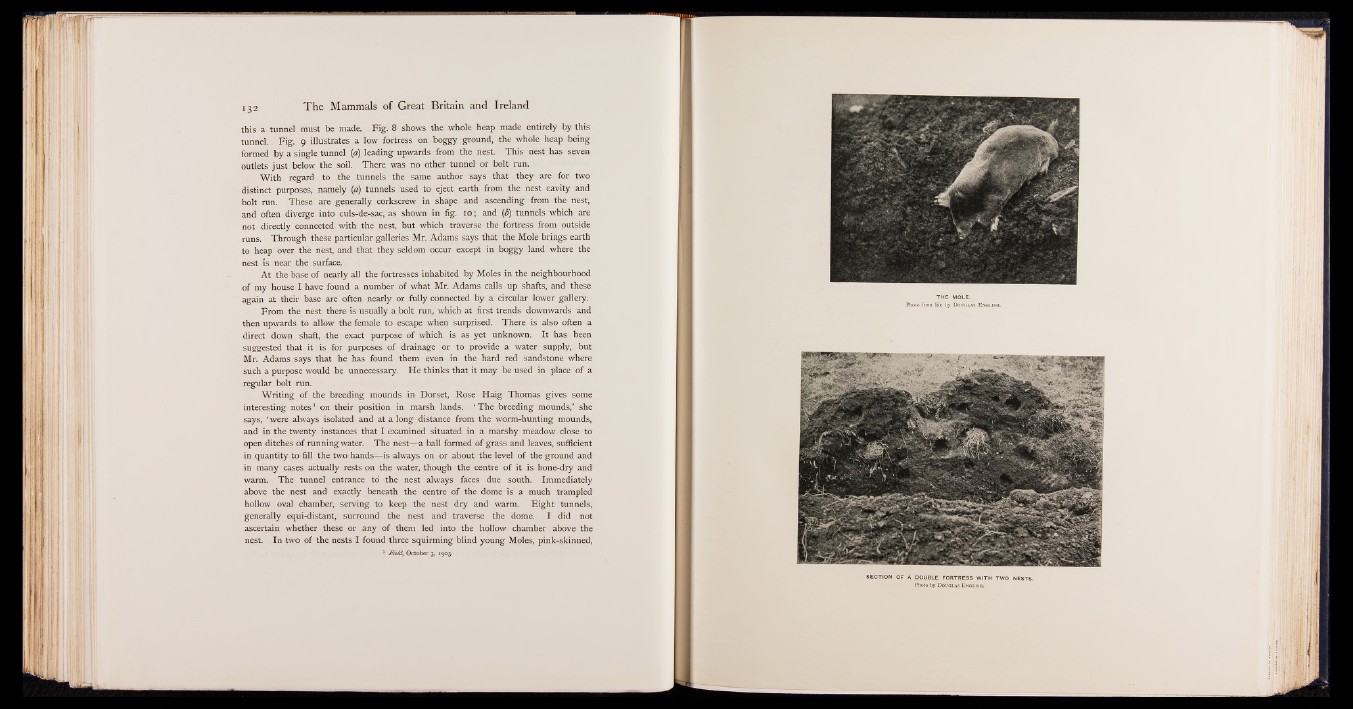
this a tunnel must be made. Fig. 8 shows the whole heap made entirely by this
tunnel. Fig. 9 illustrates a low fortress on boggy ground, the whole heap being
formed by a single tunnel (a) leading upwards from the nest. This nest has seven
outlets just below the soil. There was no other tunnel or bolt run.
With regard to the tunnels the same author says that they are for two
distinct purposes, namely (a) tunnels used to eject earth from the nest cavity and
bolt run. These are generally corkscrew in shape and ascending from the nest,
and often diverge into culs-de-sac, as shown in fig. 10; and (6) tunnels which are
not directly connected with the nest, but which traverse the fortress from outside
runs. Through these particular galleries Mr. Adams says that the Mole brings earth
to heap over the nest, and that they seldom occur except in boggy land where the
nest is near the surface.
At the base of nearly all the fortresses inhabited by Moles in the neighbourhood
of my house I have found a number of what Mr. Adams calls up shafts, and these
again at their base are often nearly or fully connected by a circular lower gallery.
From the nest there is usually a bolt run, which at first trends downwards and
then upwards to allow the female to escape when surprised. There is also often a
direct down shaft, the exact purpose of which is as yet unknown. It has been
suggested that it is for purposes of drainage or to provide a water supply, but
Mr. Adams says that he has found them even in the hard red sandstone where
such a purpose would be unnecessary. He thinks that it may be used in place of a
regular bolt run.
Writing of the breeding mounds in Dorset, Rose Haig Thomas gives some
interesting notes1 on their position in marsh lands. ‘ The breeding mounds,’ she
says, ‘ were always isolated and at a long distance from the worm-hunting mounds,
and in the twenty instances that I examined situated in a marshy meadow close to
open ditches of running water. The nest— a ball formed of grass and leaves, sufficient
in quantity to fill the two hands-—is always on or about the level of the ground and
in many cases actually rests on the water, though the centre of it is bone-dry and
warm. The tunnel entrance to the nest always faces due south. Immediately
above the nest and exactly beneath the centre of the dome is a much trampled
hollow oval chamber, serving to keep the nest dry and warm. Eight tunnels,
generally equi-distant, surround the nest and traverse the dome. I did not
ascertain whether these or any of them led into the hollow chamber above the
nest. In two of the nests I found three squirming blind young Moles, pink-skinned,
1 Field, October 3, 1903.
ijlHE MOLE.
Photo from life by Douglas English.